IT Service Management Process Analysis for GTPC Company
VerifiedAdded on 2023/04/23
|23
|4229
|156
Report
AI Summary
This report provides a comprehensive analysis of IT Service Management (ITSM) processes within the context of the Great Theme Park Company (GTPC), a large organization operating multiple theme parks. The report begins by outlining strategic business objectives, including identifying risks, developing IT service lifecycle plans, and identifying success and failure factors. It then details the company's IT service management business objectives, aligning them with ITSM operational objectives. The report also identifies potential failure factors, such as employee resistance and security issues, and outlines ten critical ITIL processes, including service strategy, design, transition, and operation. Furthermore, the report presents five critical success factors, discusses challenges in ITSM implementation, and details the implementation process along with the roles and responsibilities of staff members. The aim is to integrate the current working environment with an integrated service management system to provide effective services and facilities to customers, ultimately improving operational efficiency and profitability.

IT Service Management Process
Paraphrase This Document
Need a fresh take? Get an instant paraphrase of this document with our AI Paraphraser
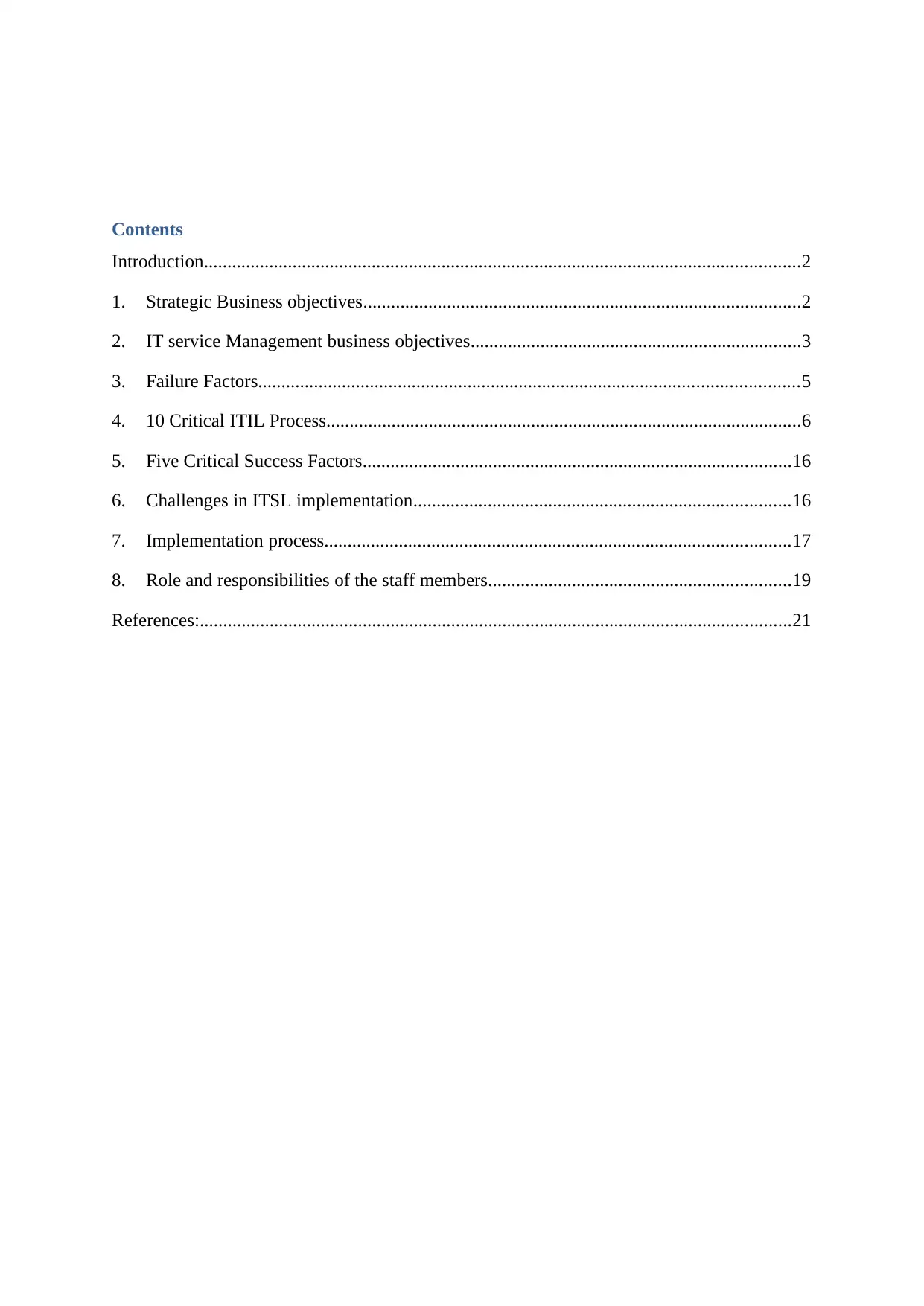
Contents
Introduction................................................................................................................................2
1. Strategic Business objectives..............................................................................................2
2. IT service Management business objectives.......................................................................3
3. Failure Factors....................................................................................................................5
4. 10 Critical ITIL Process......................................................................................................6
5. Five Critical Success Factors............................................................................................16
6. Challenges in ITSL implementation.................................................................................16
7. Implementation process....................................................................................................17
8. Role and responsibilities of the staff members.................................................................19
References:...............................................................................................................................21
Introduction................................................................................................................................2
1. Strategic Business objectives..............................................................................................2
2. IT service Management business objectives.......................................................................3
3. Failure Factors....................................................................................................................5
4. 10 Critical ITIL Process......................................................................................................6
5. Five Critical Success Factors............................................................................................16
6. Challenges in ITSL implementation.................................................................................16
7. Implementation process....................................................................................................17
8. Role and responsibilities of the staff members.................................................................19
References:...............................................................................................................................21
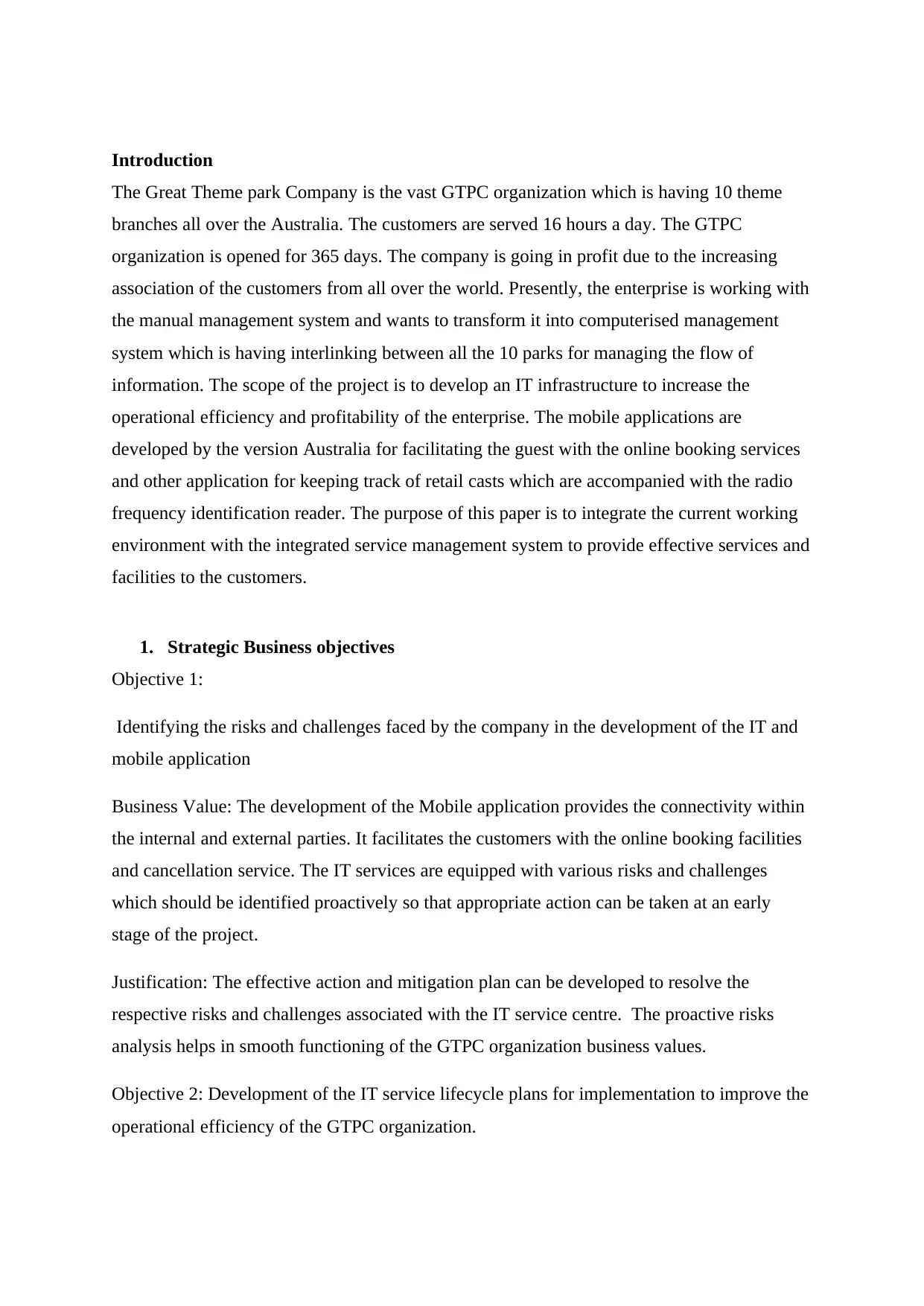
Introduction
The Great Theme park Company is the vast GTPC organization which is having 10 theme
branches all over the Australia. The customers are served 16 hours a day. The GTPC
organization is opened for 365 days. The company is going in profit due to the increasing
association of the customers from all over the world. Presently, the enterprise is working with
the manual management system and wants to transform it into computerised management
system which is having interlinking between all the 10 parks for managing the flow of
information. The scope of the project is to develop an IT infrastructure to increase the
operational efficiency and profitability of the enterprise. The mobile applications are
developed by the version Australia for facilitating the guest with the online booking services
and other application for keeping track of retail casts which are accompanied with the radio
frequency identification reader. The purpose of this paper is to integrate the current working
environment with the integrated service management system to provide effective services and
facilities to the customers.
1. Strategic Business objectives
Objective 1:
Identifying the risks and challenges faced by the company in the development of the IT and
mobile application
Business Value: The development of the Mobile application provides the connectivity within
the internal and external parties. It facilitates the customers with the online booking facilities
and cancellation service. The IT services are equipped with various risks and challenges
which should be identified proactively so that appropriate action can be taken at an early
stage of the project.
Justification: The effective action and mitigation plan can be developed to resolve the
respective risks and challenges associated with the IT service centre. The proactive risks
analysis helps in smooth functioning of the GTPC organization business values.
Objective 2: Development of the IT service lifecycle plans for implementation to improve the
operational efficiency of the GTPC organization.
The Great Theme park Company is the vast GTPC organization which is having 10 theme
branches all over the Australia. The customers are served 16 hours a day. The GTPC
organization is opened for 365 days. The company is going in profit due to the increasing
association of the customers from all over the world. Presently, the enterprise is working with
the manual management system and wants to transform it into computerised management
system which is having interlinking between all the 10 parks for managing the flow of
information. The scope of the project is to develop an IT infrastructure to increase the
operational efficiency and profitability of the enterprise. The mobile applications are
developed by the version Australia for facilitating the guest with the online booking services
and other application for keeping track of retail casts which are accompanied with the radio
frequency identification reader. The purpose of this paper is to integrate the current working
environment with the integrated service management system to provide effective services and
facilities to the customers.
1. Strategic Business objectives
Objective 1:
Identifying the risks and challenges faced by the company in the development of the IT and
mobile application
Business Value: The development of the Mobile application provides the connectivity within
the internal and external parties. It facilitates the customers with the online booking facilities
and cancellation service. The IT services are equipped with various risks and challenges
which should be identified proactively so that appropriate action can be taken at an early
stage of the project.
Justification: The effective action and mitigation plan can be developed to resolve the
respective risks and challenges associated with the IT service centre. The proactive risks
analysis helps in smooth functioning of the GTPC organization business values.
Objective 2: Development of the IT service lifecycle plans for implementation to improve the
operational efficiency of the GTPC organization.
⊘ This is a preview!⊘
Do you want full access?
Subscribe today to unlock all pages.

Trusted by 1+ million students worldwide
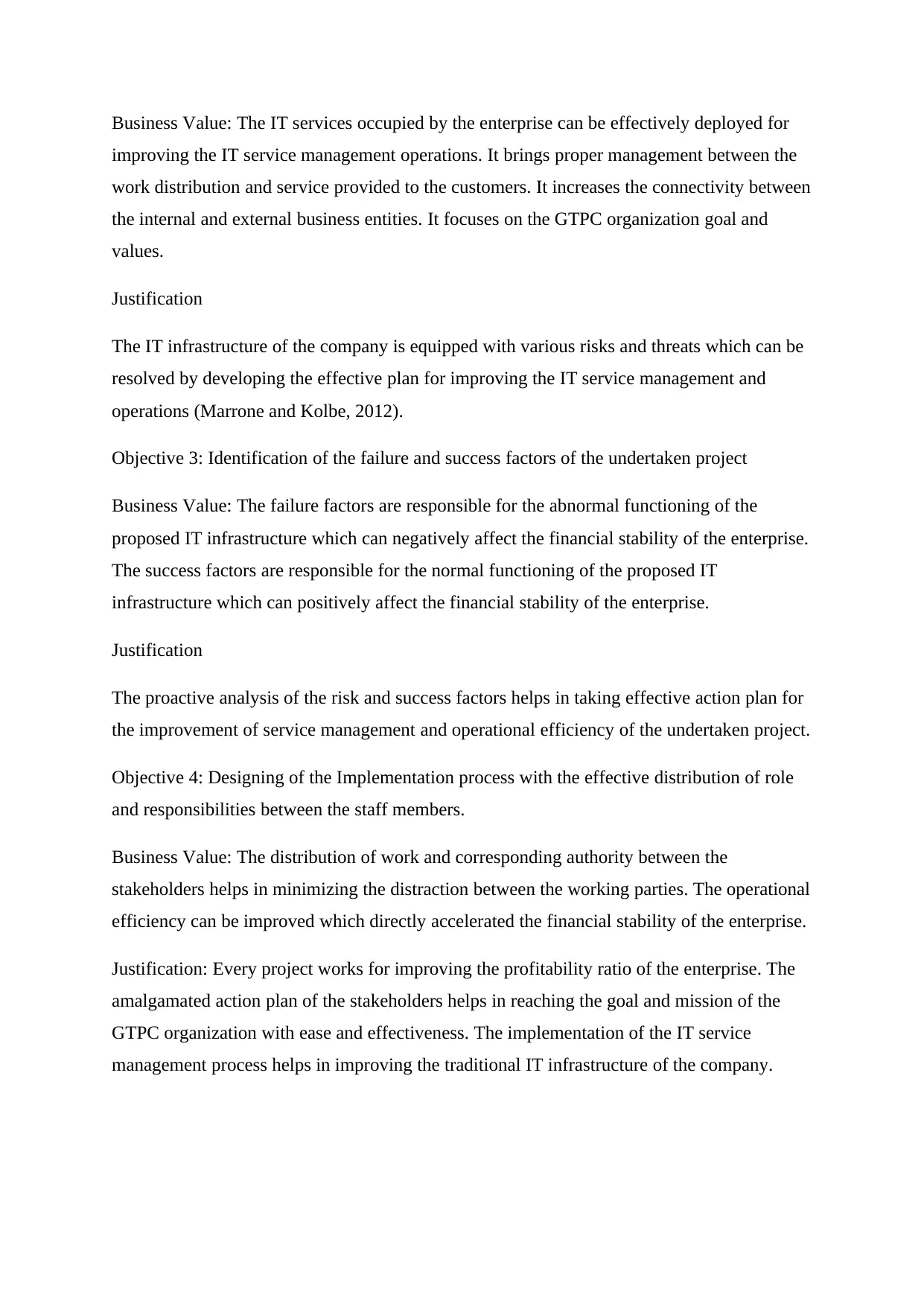
Business Value: The IT services occupied by the enterprise can be effectively deployed for
improving the IT service management operations. It brings proper management between the
work distribution and service provided to the customers. It increases the connectivity between
the internal and external business entities. It focuses on the GTPC organization goal and
values.
Justification
The IT infrastructure of the company is equipped with various risks and threats which can be
resolved by developing the effective plan for improving the IT service management and
operations (Marrone and Kolbe, 2012).
Objective 3: Identification of the failure and success factors of the undertaken project
Business Value: The failure factors are responsible for the abnormal functioning of the
proposed IT infrastructure which can negatively affect the financial stability of the enterprise.
The success factors are responsible for the normal functioning of the proposed IT
infrastructure which can positively affect the financial stability of the enterprise.
Justification
The proactive analysis of the risk and success factors helps in taking effective action plan for
the improvement of service management and operational efficiency of the undertaken project.
Objective 4: Designing of the Implementation process with the effective distribution of role
and responsibilities between the staff members.
Business Value: The distribution of work and corresponding authority between the
stakeholders helps in minimizing the distraction between the working parties. The operational
efficiency can be improved which directly accelerated the financial stability of the enterprise.
Justification: Every project works for improving the profitability ratio of the enterprise. The
amalgamated action plan of the stakeholders helps in reaching the goal and mission of the
GTPC organization with ease and effectiveness. The implementation of the IT service
management process helps in improving the traditional IT infrastructure of the company.
improving the IT service management operations. It brings proper management between the
work distribution and service provided to the customers. It increases the connectivity between
the internal and external business entities. It focuses on the GTPC organization goal and
values.
Justification
The IT infrastructure of the company is equipped with various risks and threats which can be
resolved by developing the effective plan for improving the IT service management and
operations (Marrone and Kolbe, 2012).
Objective 3: Identification of the failure and success factors of the undertaken project
Business Value: The failure factors are responsible for the abnormal functioning of the
proposed IT infrastructure which can negatively affect the financial stability of the enterprise.
The success factors are responsible for the normal functioning of the proposed IT
infrastructure which can positively affect the financial stability of the enterprise.
Justification
The proactive analysis of the risk and success factors helps in taking effective action plan for
the improvement of service management and operational efficiency of the undertaken project.
Objective 4: Designing of the Implementation process with the effective distribution of role
and responsibilities between the staff members.
Business Value: The distribution of work and corresponding authority between the
stakeholders helps in minimizing the distraction between the working parties. The operational
efficiency can be improved which directly accelerated the financial stability of the enterprise.
Justification: Every project works for improving the profitability ratio of the enterprise. The
amalgamated action plan of the stakeholders helps in reaching the goal and mission of the
GTPC organization with ease and effectiveness. The implementation of the IT service
management process helps in improving the traditional IT infrastructure of the company.
Paraphrase This Document
Need a fresh take? Get an instant paraphrase of this document with our AI Paraphraser
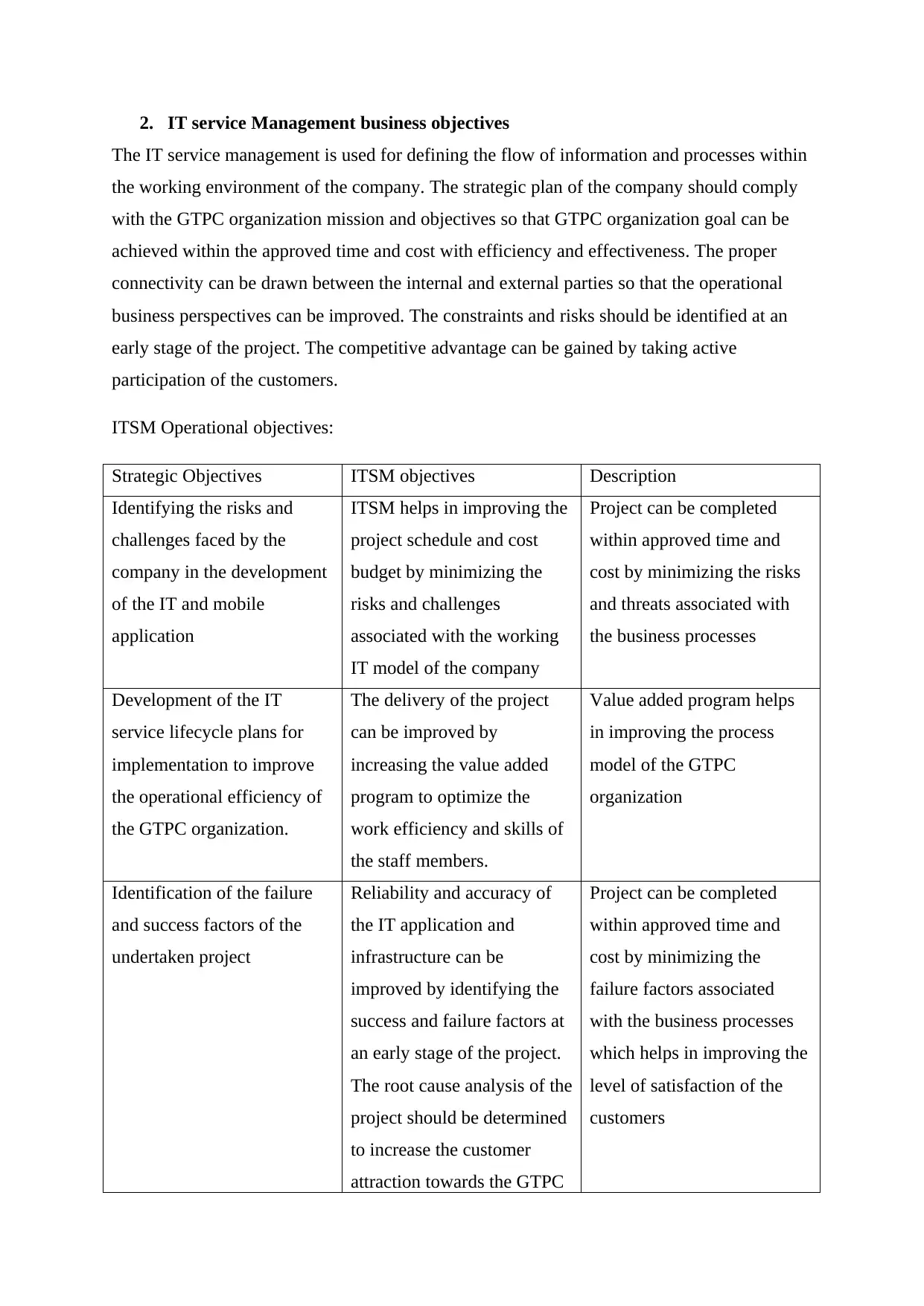
2. IT service Management business objectives
The IT service management is used for defining the flow of information and processes within
the working environment of the company. The strategic plan of the company should comply
with the GTPC organization mission and objectives so that GTPC organization goal can be
achieved within the approved time and cost with efficiency and effectiveness. The proper
connectivity can be drawn between the internal and external parties so that the operational
business perspectives can be improved. The constraints and risks should be identified at an
early stage of the project. The competitive advantage can be gained by taking active
participation of the customers.
ITSM Operational objectives:
Strategic Objectives ITSM objectives Description
Identifying the risks and
challenges faced by the
company in the development
of the IT and mobile
application
ITSM helps in improving the
project schedule and cost
budget by minimizing the
risks and challenges
associated with the working
IT model of the company
Project can be completed
within approved time and
cost by minimizing the risks
and threats associated with
the business processes
Development of the IT
service lifecycle plans for
implementation to improve
the operational efficiency of
the GTPC organization.
The delivery of the project
can be improved by
increasing the value added
program to optimize the
work efficiency and skills of
the staff members.
Value added program helps
in improving the process
model of the GTPC
organization
Identification of the failure
and success factors of the
undertaken project
Reliability and accuracy of
the IT application and
infrastructure can be
improved by identifying the
success and failure factors at
an early stage of the project.
The root cause analysis of the
project should be determined
to increase the customer
attraction towards the GTPC
Project can be completed
within approved time and
cost by minimizing the
failure factors associated
with the business processes
which helps in improving the
level of satisfaction of the
customers
The IT service management is used for defining the flow of information and processes within
the working environment of the company. The strategic plan of the company should comply
with the GTPC organization mission and objectives so that GTPC organization goal can be
achieved within the approved time and cost with efficiency and effectiveness. The proper
connectivity can be drawn between the internal and external parties so that the operational
business perspectives can be improved. The constraints and risks should be identified at an
early stage of the project. The competitive advantage can be gained by taking active
participation of the customers.
ITSM Operational objectives:
Strategic Objectives ITSM objectives Description
Identifying the risks and
challenges faced by the
company in the development
of the IT and mobile
application
ITSM helps in improving the
project schedule and cost
budget by minimizing the
risks and challenges
associated with the working
IT model of the company
Project can be completed
within approved time and
cost by minimizing the risks
and threats associated with
the business processes
Development of the IT
service lifecycle plans for
implementation to improve
the operational efficiency of
the GTPC organization.
The delivery of the project
can be improved by
increasing the value added
program to optimize the
work efficiency and skills of
the staff members.
Value added program helps
in improving the process
model of the GTPC
organization
Identification of the failure
and success factors of the
undertaken project
Reliability and accuracy of
the IT application and
infrastructure can be
improved by identifying the
success and failure factors at
an early stage of the project.
The root cause analysis of the
project should be determined
to increase the customer
attraction towards the GTPC
Project can be completed
within approved time and
cost by minimizing the
failure factors associated
with the business processes
which helps in improving the
level of satisfaction of the
customers
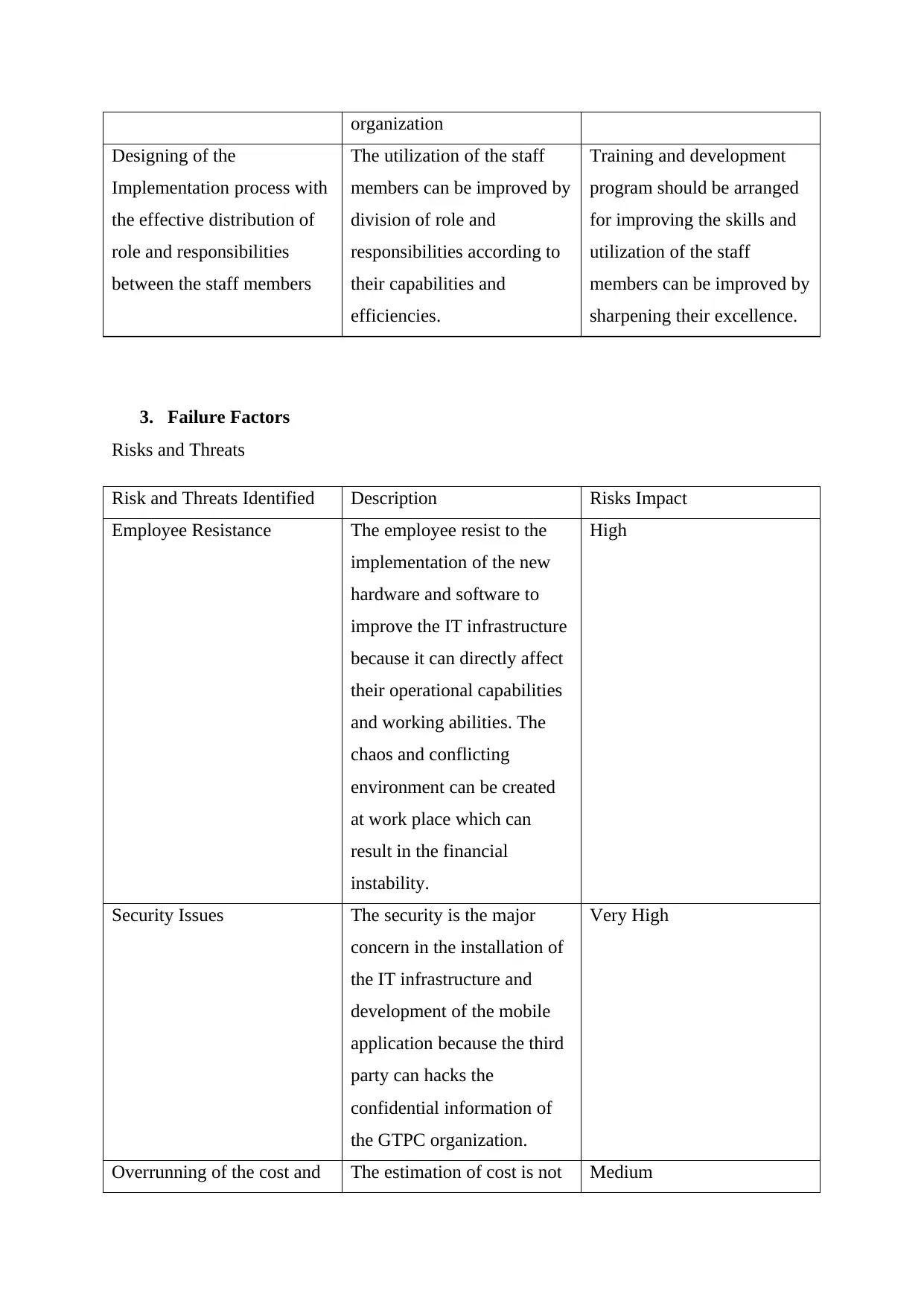
organization
Designing of the
Implementation process with
the effective distribution of
role and responsibilities
between the staff members
The utilization of the staff
members can be improved by
division of role and
responsibilities according to
their capabilities and
efficiencies.
Training and development
program should be arranged
for improving the skills and
utilization of the staff
members can be improved by
sharpening their excellence.
3. Failure Factors
Risks and Threats
Risk and Threats Identified Description Risks Impact
Employee Resistance The employee resist to the
implementation of the new
hardware and software to
improve the IT infrastructure
because it can directly affect
their operational capabilities
and working abilities. The
chaos and conflicting
environment can be created
at work place which can
result in the financial
instability.
High
Security Issues The security is the major
concern in the installation of
the IT infrastructure and
development of the mobile
application because the third
party can hacks the
confidential information of
the GTPC organization.
Very High
Overrunning of the cost and The estimation of cost is not Medium
Designing of the
Implementation process with
the effective distribution of
role and responsibilities
between the staff members
The utilization of the staff
members can be improved by
division of role and
responsibilities according to
their capabilities and
efficiencies.
Training and development
program should be arranged
for improving the skills and
utilization of the staff
members can be improved by
sharpening their excellence.
3. Failure Factors
Risks and Threats
Risk and Threats Identified Description Risks Impact
Employee Resistance The employee resist to the
implementation of the new
hardware and software to
improve the IT infrastructure
because it can directly affect
their operational capabilities
and working abilities. The
chaos and conflicting
environment can be created
at work place which can
result in the financial
instability.
High
Security Issues The security is the major
concern in the installation of
the IT infrastructure and
development of the mobile
application because the third
party can hacks the
confidential information of
the GTPC organization.
Very High
Overrunning of the cost and The estimation of cost is not Medium
⊘ This is a preview!⊘
Do you want full access?
Subscribe today to unlock all pages.

Trusted by 1+ million students worldwide
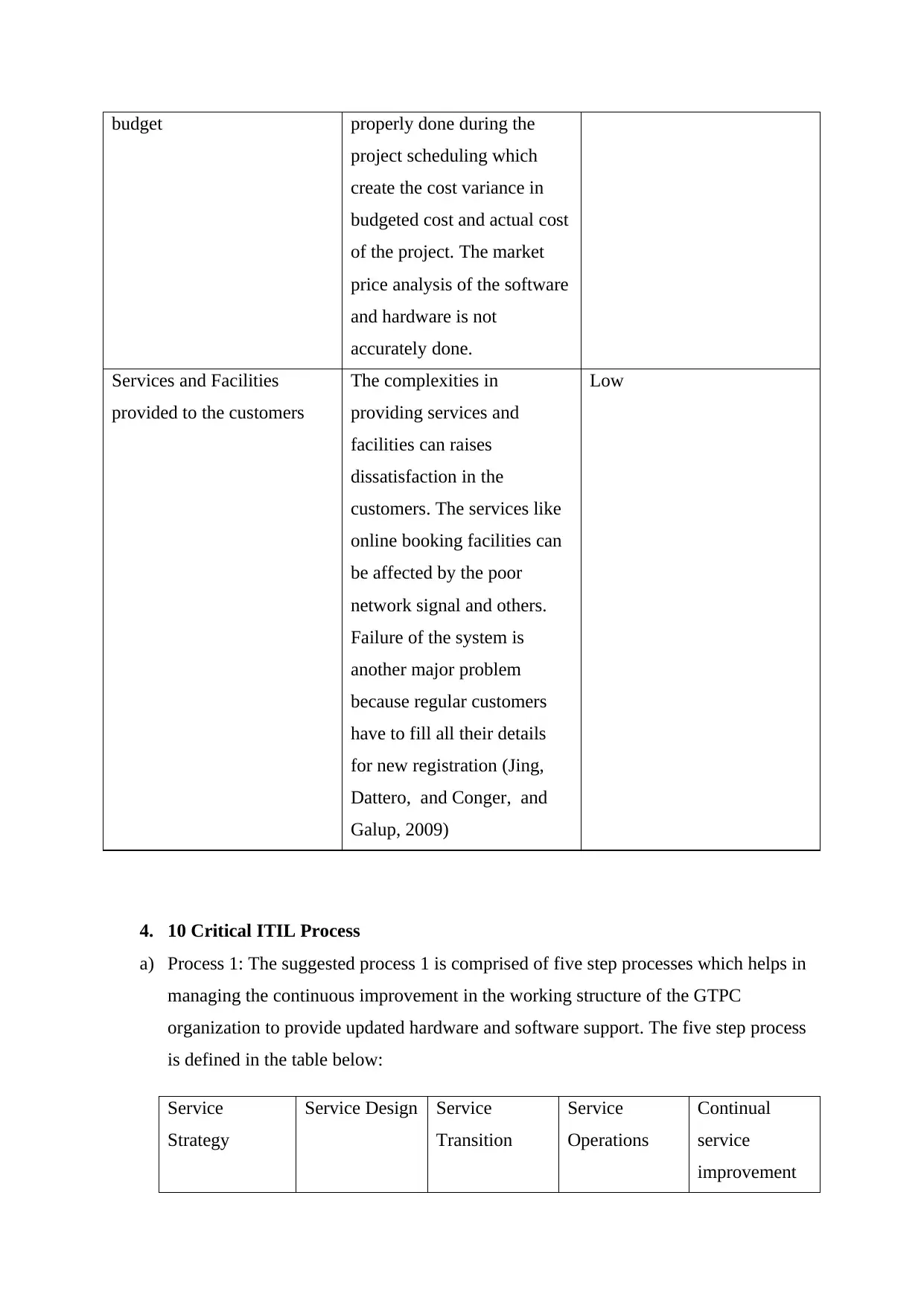
budget properly done during the
project scheduling which
create the cost variance in
budgeted cost and actual cost
of the project. The market
price analysis of the software
and hardware is not
accurately done.
Services and Facilities
provided to the customers
The complexities in
providing services and
facilities can raises
dissatisfaction in the
customers. The services like
online booking facilities can
be affected by the poor
network signal and others.
Failure of the system is
another major problem
because regular customers
have to fill all their details
for new registration (Jing,
Dattero, and Conger, and
Galup, 2009)
Low
4. 10 Critical ITIL Process
a) Process 1: The suggested process 1 is comprised of five step processes which helps in
managing the continuous improvement in the working structure of the GTPC
organization to provide updated hardware and software support. The five step process
is defined in the table below:
Service
Strategy
Service Design Service
Transition
Service
Operations
Continual
service
improvement
project scheduling which
create the cost variance in
budgeted cost and actual cost
of the project. The market
price analysis of the software
and hardware is not
accurately done.
Services and Facilities
provided to the customers
The complexities in
providing services and
facilities can raises
dissatisfaction in the
customers. The services like
online booking facilities can
be affected by the poor
network signal and others.
Failure of the system is
another major problem
because regular customers
have to fill all their details
for new registration (Jing,
Dattero, and Conger, and
Galup, 2009)
Low
4. 10 Critical ITIL Process
a) Process 1: The suggested process 1 is comprised of five step processes which helps in
managing the continuous improvement in the working structure of the GTPC
organization to provide updated hardware and software support. The five step process
is defined in the table below:
Service
Strategy
Service Design Service
Transition
Service
Operations
Continual
service
improvement
Paraphrase This Document
Need a fresh take? Get an instant paraphrase of this document with our AI Paraphraser
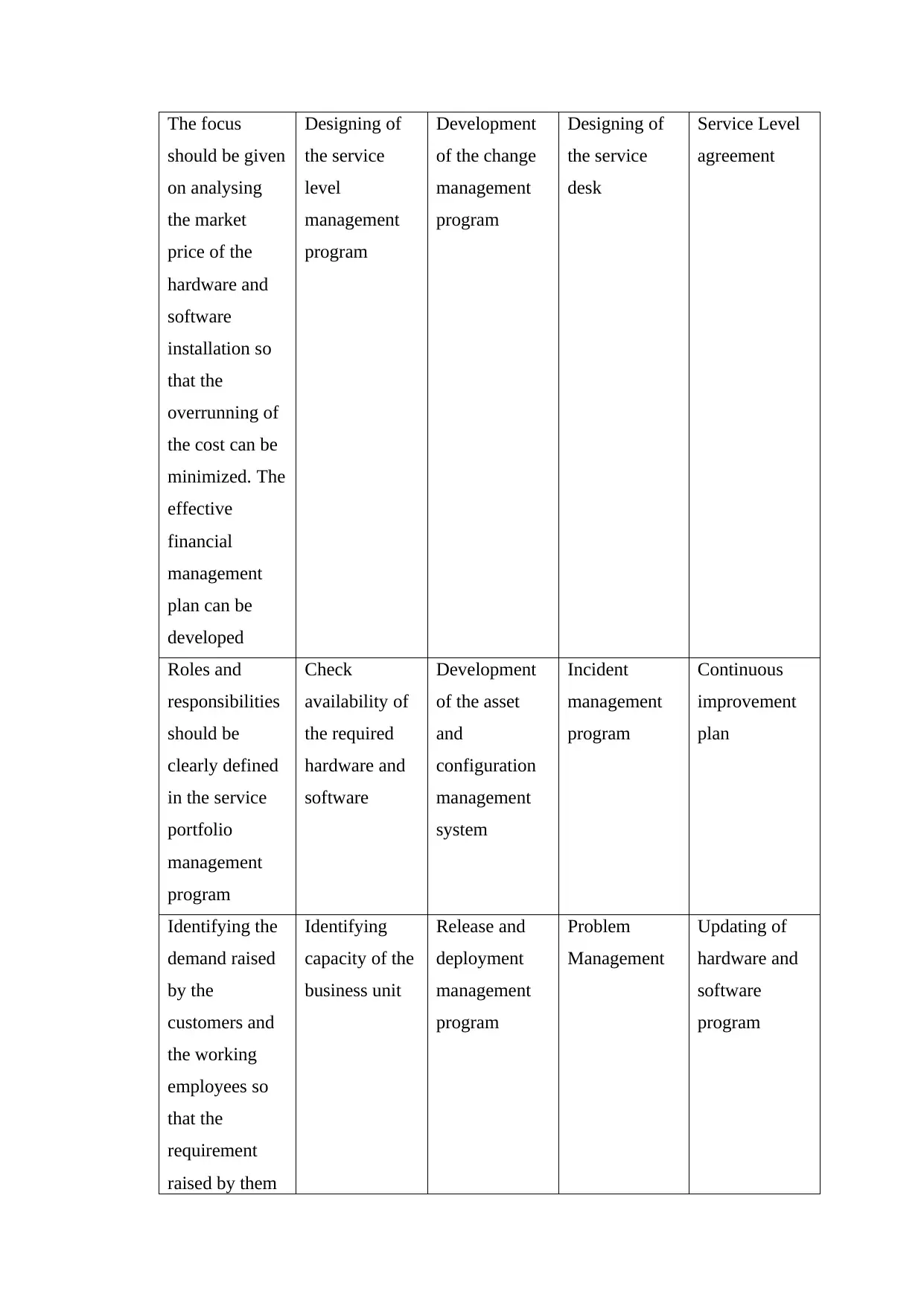
The focus
should be given
on analysing
the market
price of the
hardware and
software
installation so
that the
overrunning of
the cost can be
minimized. The
effective
financial
management
plan can be
developed
Designing of
the service
level
management
program
Development
of the change
management
program
Designing of
the service
desk
Service Level
agreement
Roles and
responsibilities
should be
clearly defined
in the service
portfolio
management
program
Check
availability of
the required
hardware and
software
Development
of the asset
and
configuration
management
system
Incident
management
program
Continuous
improvement
plan
Identifying the
demand raised
by the
customers and
the working
employees so
that the
requirement
raised by them
Identifying
capacity of the
business unit
Release and
deployment
management
program
Problem
Management
Updating of
hardware and
software
program
should be given
on analysing
the market
price of the
hardware and
software
installation so
that the
overrunning of
the cost can be
minimized. The
effective
financial
management
plan can be
developed
Designing of
the service
level
management
program
Development
of the change
management
program
Designing of
the service
desk
Service Level
agreement
Roles and
responsibilities
should be
clearly defined
in the service
portfolio
management
program
Check
availability of
the required
hardware and
software
Development
of the asset
and
configuration
management
system
Incident
management
program
Continuous
improvement
plan
Identifying the
demand raised
by the
customers and
the working
employees so
that the
requirement
raised by them
Identifying
capacity of the
business unit
Release and
deployment
management
program
Problem
Management
Updating of
hardware and
software
program
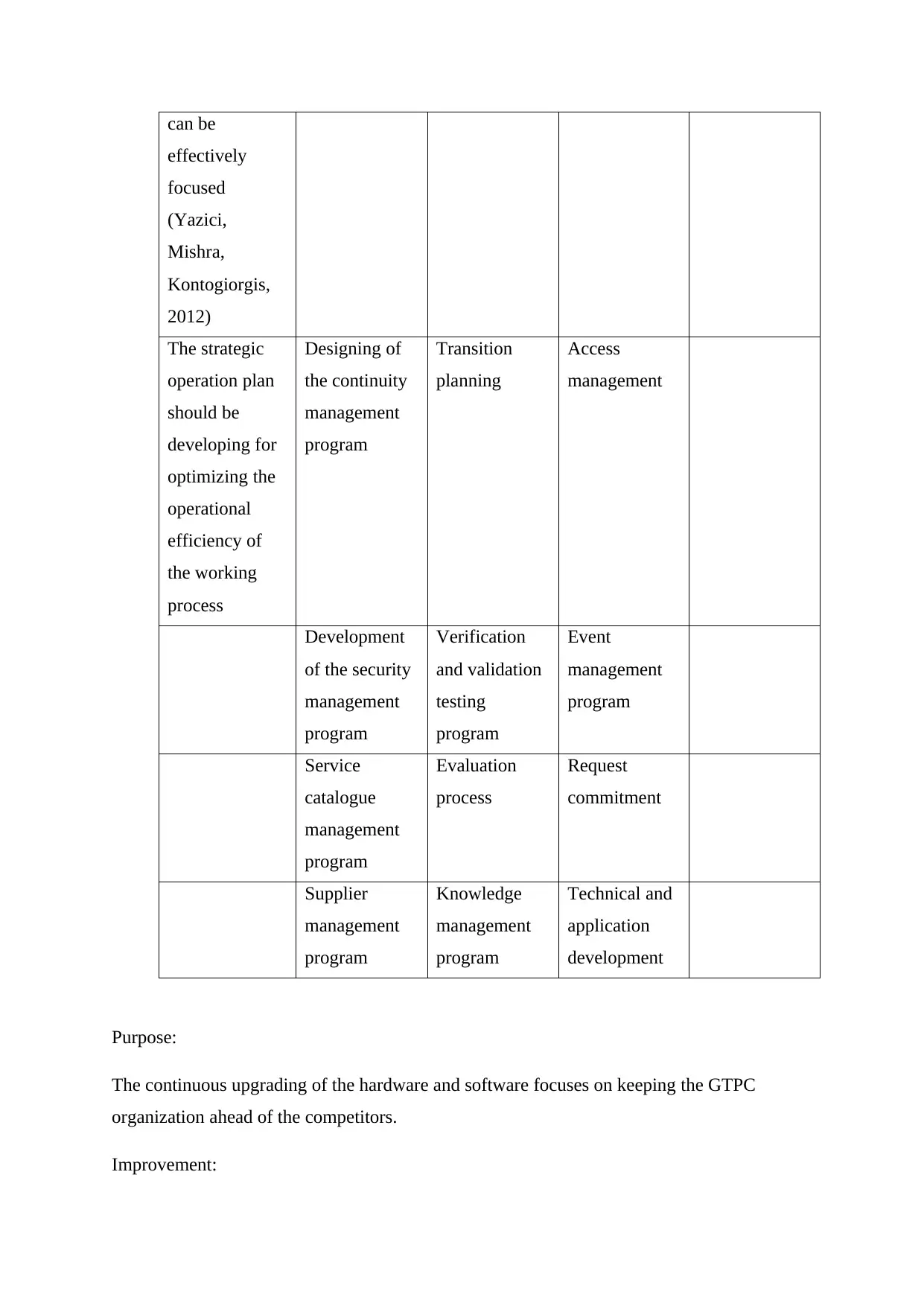
can be
effectively
focused
(Yazici,
Mishra,
Kontogiorgis,
2012)
The strategic
operation plan
should be
developing for
optimizing the
operational
efficiency of
the working
process
Designing of
the continuity
management
program
Transition
planning
Access
management
Development
of the security
management
program
Verification
and validation
testing
program
Event
management
program
Service
catalogue
management
program
Evaluation
process
Request
commitment
Supplier
management
program
Knowledge
management
program
Technical and
application
development
Purpose:
The continuous upgrading of the hardware and software focuses on keeping the GTPC
organization ahead of the competitors.
Improvement:
effectively
focused
(Yazici,
Mishra,
Kontogiorgis,
2012)
The strategic
operation plan
should be
developing for
optimizing the
operational
efficiency of
the working
process
Designing of
the continuity
management
program
Transition
planning
Access
management
Development
of the security
management
program
Verification
and validation
testing
program
Event
management
program
Service
catalogue
management
program
Evaluation
process
Request
commitment
Supplier
management
program
Knowledge
management
program
Technical and
application
development
Purpose:
The continuous upgrading of the hardware and software focuses on keeping the GTPC
organization ahead of the competitors.
Improvement:
⊘ This is a preview!⊘
Do you want full access?
Subscribe today to unlock all pages.

Trusted by 1+ million students worldwide
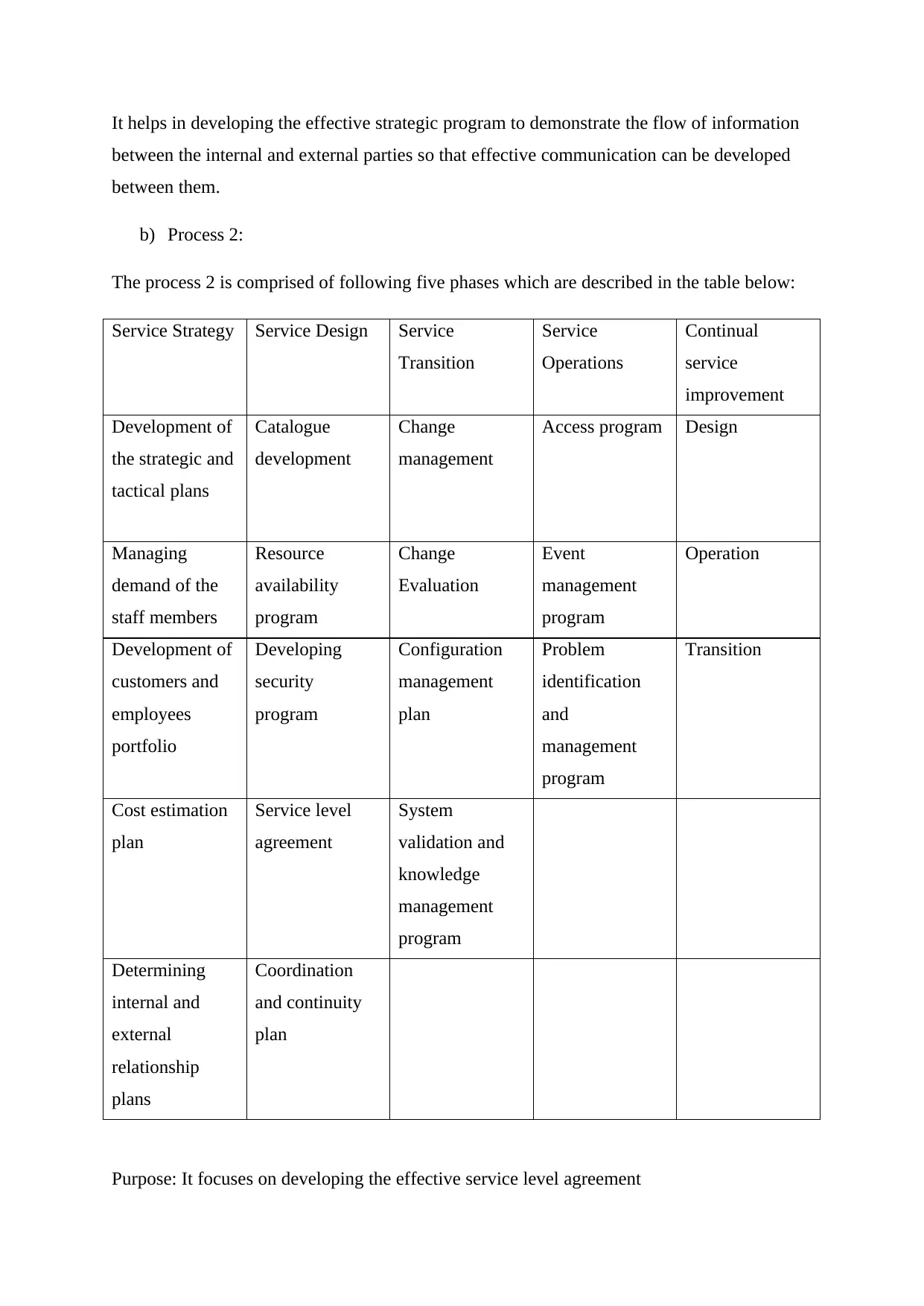
It helps in developing the effective strategic program to demonstrate the flow of information
between the internal and external parties so that effective communication can be developed
between them.
b) Process 2:
The process 2 is comprised of following five phases which are described in the table below:
Service Strategy Service Design Service
Transition
Service
Operations
Continual
service
improvement
Development of
the strategic and
tactical plans
Catalogue
development
Change
management
Access program Design
Managing
demand of the
staff members
Resource
availability
program
Change
Evaluation
Event
management
program
Operation
Development of
customers and
employees
portfolio
Developing
security
program
Configuration
management
plan
Problem
identification
and
management
program
Transition
Cost estimation
plan
Service level
agreement
System
validation and
knowledge
management
program
Determining
internal and
external
relationship
plans
Coordination
and continuity
plan
Purpose: It focuses on developing the effective service level agreement
between the internal and external parties so that effective communication can be developed
between them.
b) Process 2:
The process 2 is comprised of following five phases which are described in the table below:
Service Strategy Service Design Service
Transition
Service
Operations
Continual
service
improvement
Development of
the strategic and
tactical plans
Catalogue
development
Change
management
Access program Design
Managing
demand of the
staff members
Resource
availability
program
Change
Evaluation
Event
management
program
Operation
Development of
customers and
employees
portfolio
Developing
security
program
Configuration
management
plan
Problem
identification
and
management
program
Transition
Cost estimation
plan
Service level
agreement
System
validation and
knowledge
management
program
Determining
internal and
external
relationship
plans
Coordination
and continuity
plan
Purpose: It focuses on developing the effective service level agreement
Paraphrase This Document
Need a fresh take? Get an instant paraphrase of this document with our AI Paraphraser
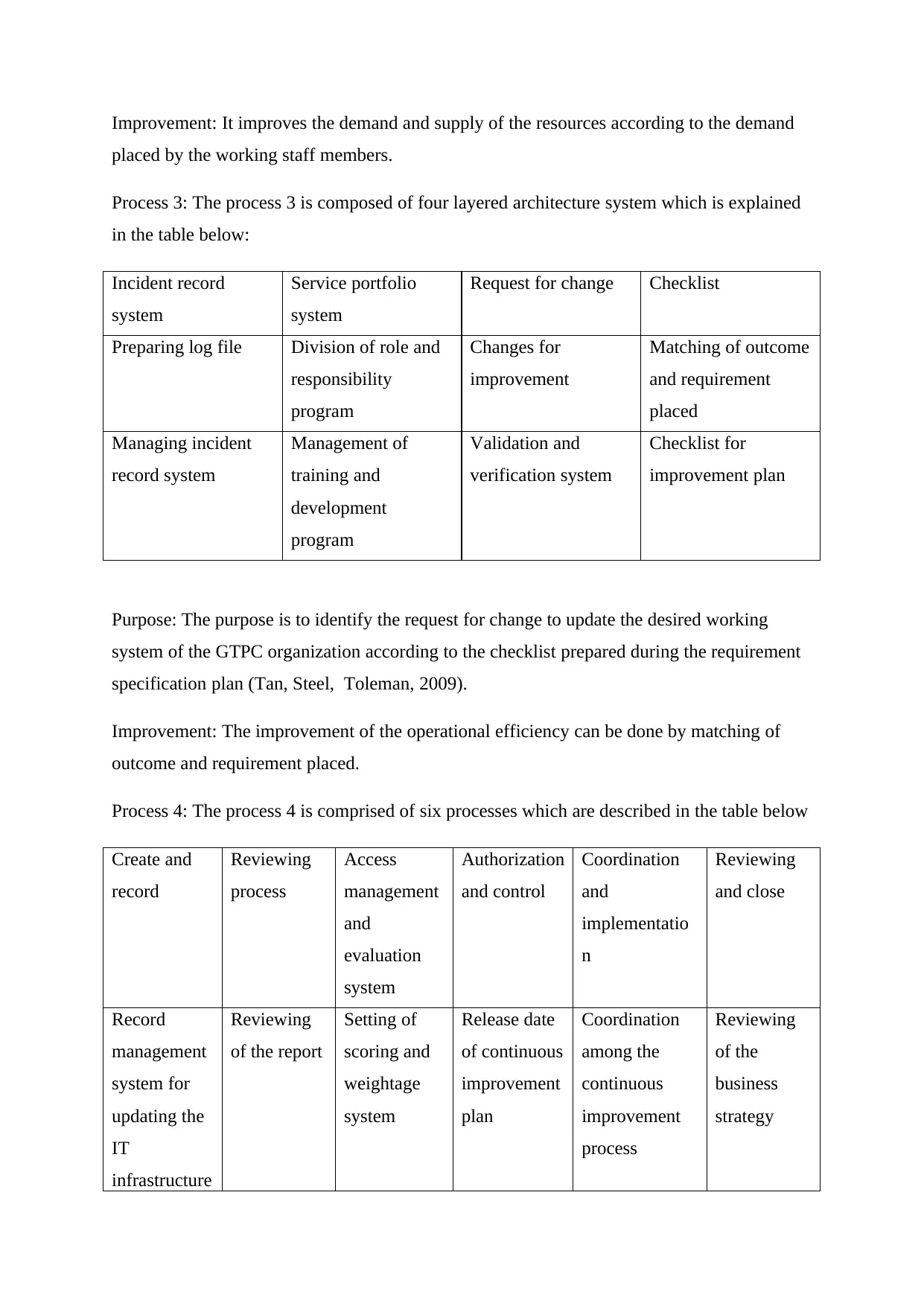
Improvement: It improves the demand and supply of the resources according to the demand
placed by the working staff members.
Process 3: The process 3 is composed of four layered architecture system which is explained
in the table below:
Incident record
system
Service portfolio
system
Request for change Checklist
Preparing log file Division of role and
responsibility
program
Changes for
improvement
Matching of outcome
and requirement
placed
Managing incident
record system
Management of
training and
development
program
Validation and
verification system
Checklist for
improvement plan
Purpose: The purpose is to identify the request for change to update the desired working
system of the GTPC organization according to the checklist prepared during the requirement
specification plan (Tan, Steel, Toleman, 2009).
Improvement: The improvement of the operational efficiency can be done by matching of
outcome and requirement placed.
Process 4: The process 4 is comprised of six processes which are described in the table below
Create and
record
Reviewing
process
Access
management
and
evaluation
system
Authorization
and control
Coordination
and
implementatio
n
Reviewing
and close
Record
management
system for
updating the
IT
infrastructure
Reviewing
of the report
Setting of
scoring and
weightage
system
Release date
of continuous
improvement
plan
Coordination
among the
continuous
improvement
process
Reviewing
of the
business
strategy
placed by the working staff members.
Process 3: The process 3 is composed of four layered architecture system which is explained
in the table below:
Incident record
system
Service portfolio
system
Request for change Checklist
Preparing log file Division of role and
responsibility
program
Changes for
improvement
Matching of outcome
and requirement
placed
Managing incident
record system
Management of
training and
development
program
Validation and
verification system
Checklist for
improvement plan
Purpose: The purpose is to identify the request for change to update the desired working
system of the GTPC organization according to the checklist prepared during the requirement
specification plan (Tan, Steel, Toleman, 2009).
Improvement: The improvement of the operational efficiency can be done by matching of
outcome and requirement placed.
Process 4: The process 4 is comprised of six processes which are described in the table below
Create and
record
Reviewing
process
Access
management
and
evaluation
system
Authorization
and control
Coordination
and
implementatio
n
Reviewing
and close
Record
management
system for
updating the
IT
infrastructure
Reviewing
of the report
Setting of
scoring and
weightage
system
Release date
of continuous
improvement
plan
Coordination
among the
continuous
improvement
process
Reviewing
of the
business
strategy
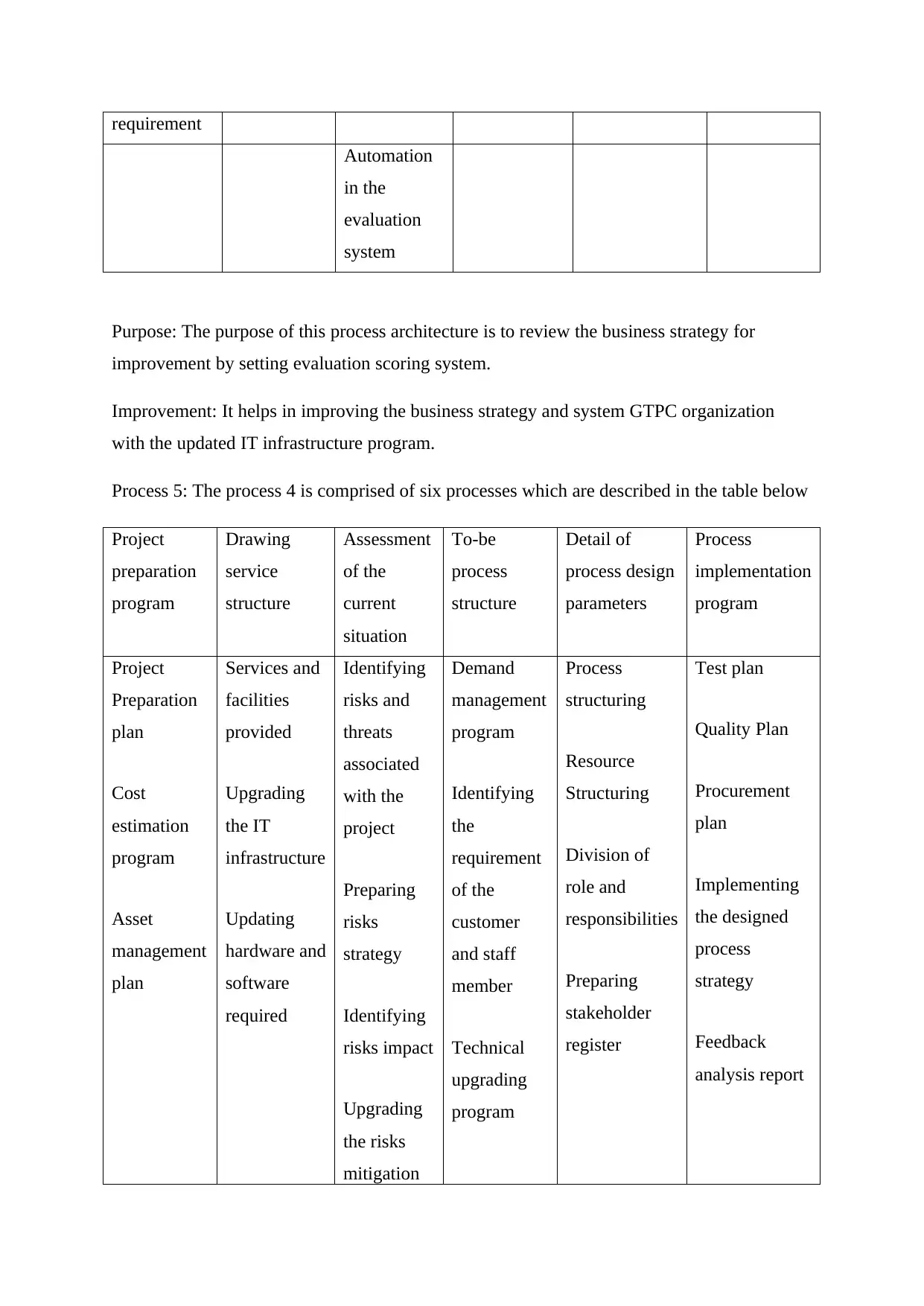
requirement
Automation
in the
evaluation
system
Purpose: The purpose of this process architecture is to review the business strategy for
improvement by setting evaluation scoring system.
Improvement: It helps in improving the business strategy and system GTPC organization
with the updated IT infrastructure program.
Process 5: The process 4 is comprised of six processes which are described in the table below
Project
preparation
program
Drawing
service
structure
Assessment
of the
current
situation
To-be
process
structure
Detail of
process design
parameters
Process
implementation
program
Project
Preparation
plan
Cost
estimation
program
Asset
management
plan
Services and
facilities
provided
Upgrading
the IT
infrastructure
Updating
hardware and
software
required
Identifying
risks and
threats
associated
with the
project
Preparing
risks
strategy
Identifying
risks impact
Upgrading
the risks
mitigation
Demand
management
program
Identifying
the
requirement
of the
customer
and staff
member
Technical
upgrading
program
Process
structuring
Resource
Structuring
Division of
role and
responsibilities
Preparing
stakeholder
register
Test plan
Quality Plan
Procurement
plan
Implementing
the designed
process
strategy
Feedback
analysis report
Automation
in the
evaluation
system
Purpose: The purpose of this process architecture is to review the business strategy for
improvement by setting evaluation scoring system.
Improvement: It helps in improving the business strategy and system GTPC organization
with the updated IT infrastructure program.
Process 5: The process 4 is comprised of six processes which are described in the table below
Project
preparation
program
Drawing
service
structure
Assessment
of the
current
situation
To-be
process
structure
Detail of
process design
parameters
Process
implementation
program
Project
Preparation
plan
Cost
estimation
program
Asset
management
plan
Services and
facilities
provided
Upgrading
the IT
infrastructure
Updating
hardware and
software
required
Identifying
risks and
threats
associated
with the
project
Preparing
risks
strategy
Identifying
risks impact
Upgrading
the risks
mitigation
Demand
management
program
Identifying
the
requirement
of the
customer
and staff
member
Technical
upgrading
program
Process
structuring
Resource
Structuring
Division of
role and
responsibilities
Preparing
stakeholder
register
Test plan
Quality Plan
Procurement
plan
Implementing
the designed
process
strategy
Feedback
analysis report
⊘ This is a preview!⊘
Do you want full access?
Subscribe today to unlock all pages.

Trusted by 1+ million students worldwide
1 out of 23
Related Documents
Your All-in-One AI-Powered Toolkit for Academic Success.
+13062052269
info@desklib.com
Available 24*7 on WhatsApp / Email
![[object Object]](/_next/static/media/star-bottom.7253800d.svg)
Unlock your academic potential
Copyright © 2020–2025 A2Z Services. All Rights Reserved. Developed and managed by ZUCOL.




